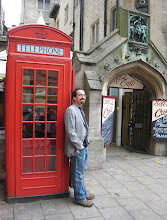Although it is hard to complain about the sunshine of Santa Barbara, life at KITP isn’t all beach volleyball – I’ve actually been working pretty hard out here. In addition to doing research (the physics kind, not the beach volleyball kind), in the span of only two weeks I am giving three talks on three totally different topics – and none of them are canned talks that I can give without much additional preparation.
Today’s talk is probably the most accessible of the three: “Topological Phases of Matter, Interesting and Useful”. It is posted on the web here. This talk is aimed at physicists not necessarily in my field. Anyone with an undergrad level education in physics should have a fair chance of understanding most of it. I recommend it for the curious. [Note added: About 7-8 minutes in, strictly speaking I make a mathematical mistake. See below for a description of the mistake]
Last Thursday I gave this talk. It has already been commented that to non-scientists I look completely silly wearing a sports jacket over a peanuts t-shirt, but amongst physicists this is not seen as strange. The topic of the talk is quantum Hall bilayers – the nu=1/2 +1/2 problem. This is a somewhat specialized talk and probably only the hbar condensed matter physicists will find it interesting or accessible. About 51-52 minutes into the talk I get busted trying to give a quick proof of a complicated fact, and the proof turns out to be wrong. (Matthew Fisher was the one who caught it immediately). I realized right away that the argument was crap. Nonetheless, it was a bit of a red-faced moment. It doesn’t matter too much though, because you can prove the result in a more complicated way.
(For the physicists reading this, I was trying to give a two line proof that a px+ipy spin triplet superconductor has quantum spin Hall effect. There is a detailed proof in Read and Green PRB 2000, but it is not particularly simple. There is probably a cleaner way to prove it based on following the band structure and discovering one putatively localized band stretches across the system, but I haven’t worked this through – it has probably been done by someone already anyhow. Also for the interested physicist, this talk was based on two recent papers with Gunnar Moller and Ed Rezayi. The papers are here and here).
Next Wednesday I give a talk across the street at Microsoft Station Q. The topic of this talk is the project I’ve been working on with Fiona Burnell. I confess I’m a bit frightened about giving this talk – probably for good reason: Our arguments wander off into four dimensional topology before returning to physics, and one of the people in the audience will be Michael Freedman – who has a Field’s medal for work in four dimensional topology. If there is anyone in the world who will be able to instantly see weaknesses of our work, it is likely to be him. Even more frightening is the possibility that he (or someone else at station Q, possibly Kevin Walker) says, “oh yes, this is all known”. I’ll keep you updated on how this goes. At some point I’ll try to explain roughly what we are doing, but right now we don’t have all that simple a version.
[Added note from above: Regarding the mistake I mention above. Zhenghan Wang, a very good mathematician, points out that it is not true that no knot invariant exists that can distinguish all knots from each other. I define a knot invariant as any map from a knot as in input to any output. A trivial example, strictly speaking, is the identity map. Unfortunately, it is just as hard to compare the outputs as it was to compare the original knots. Nonetheless, to be precise, it is true that the output of the identity map distinguishes all knots from each other. A less trivial example is that the compliment of the knot within the manifold S3 also fully distinguishes all knots].
Subscribe to:
Post Comments (Atom)

No comments:
Post a Comment